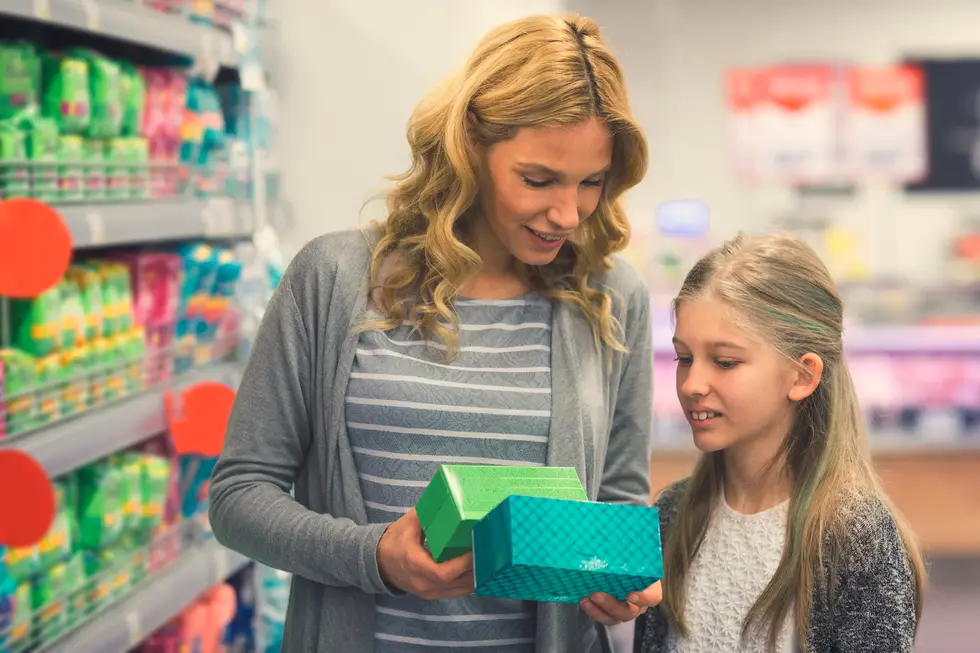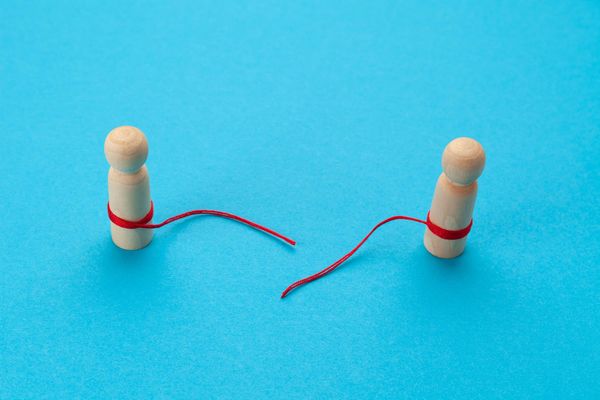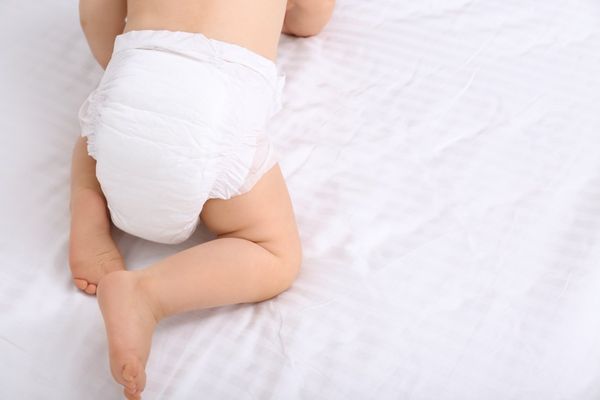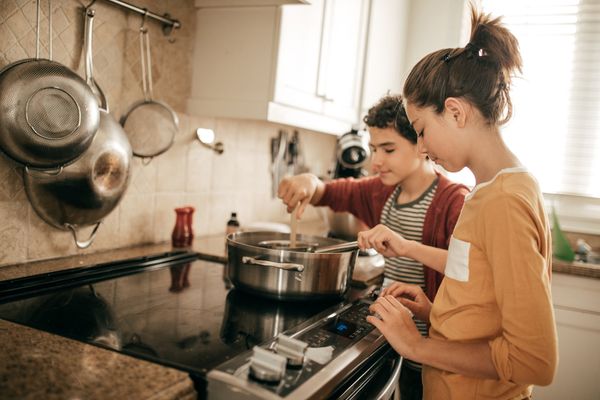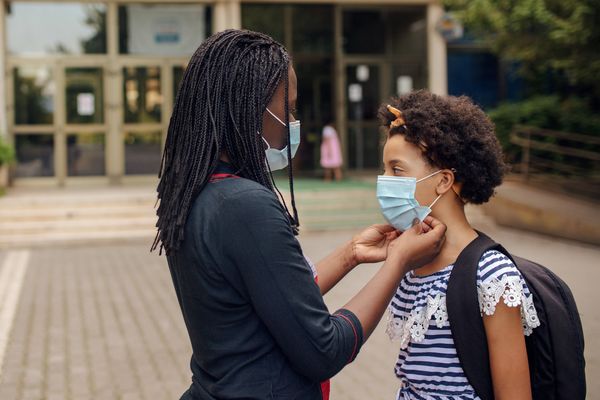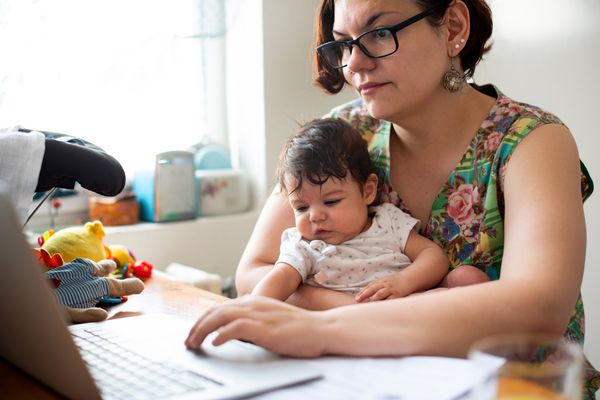Although you will see signs that your teen is in puberty, her first period may still be somewhat unexpected. Some young women are frightened by the sight of bleeding or embarrassed if it causes a stain on their underwear or clothing. As a mother or caretaker, it will help if you talk to your teen about her impending periods and what she can expect. It's important to remind her that it is natural and that every woman goes through. You can also give her tips on how to prepare for her period ahead of time, so she's not taken by surprise when it shows up. For example, you can give her pads and panty liners to carry with her in her backpack or purse.
Some of the next information you probably already know, but it can help you explain to your teen what's going on within her body, as well as what having her first period signifies in her development:
Explaining what's happening in her body.
A girl's first period is likely to occur between the ages of nine and 16. It usually lasts for three to seven days and then stops until the next period begins—usually about 21 to 28 days after it started. This timeframe—from the first day of bleeding until the first day of the NEXT menstrual period—is called a "menstrual cycle."
During a typical menstrual cycle, one of two ovaries releases a microscopic egg, called an ovum. (The ovaries are reproductive organs approximately one and a half inches long and located in the lower abdomen, one on each side of the uterus; ovaries also release hormones that help to control the menstrual cycle.) The release of an egg from an ovary is called "ovulation," and it usually happens in the middle of the menstrual cycle—around day 12 to 14 in a 28-day cycle. Ovulation can be irregular, though, when periods first start.
After ovulation, the egg moves through one of the two fallopian tubes (the two tubes attached to the top of the uterus that lead to the ovaries). At the same time, body tissues and blood cells are beginning to line the walls of the uterus, forming a thin layer of material that will eventually be shed as the next period. All this goes on in a woman's body without her feeling a thing.
Important things to mention about sexual activity.
Depending on your teen's age, you may want to explain to her that if she were to have sexual intercourse around the time of ovulation, and sperm from a male partner would fertilize the egg on its way to the uterus, she would become pregnant. The egg would attach to the lining of the uterus and a fetus would start to grow. However, if sperm does not fertilize the egg, the body no longer needs this lining to support the fertilized egg. So, hormones trigger a different process, and this lining gently falls away from the walls of the uterus and comes out through the vagina. This is the menstrual flow, or period.
What she'll need.
To avoid staining her clothes, your teen will need to use sanitary pads, panty liners or tampons during her period. Sanitary pads and panty liners fit inside her underwear and stay in place with an adhesive strip on the back of the pad. There are a variety of pads available with various thicknesses, lengths and absorbencies. Panty liners are good for the beginning or end of a period, when the flow is lighter.
Tampons, which are inserted into the vagina to absorb menstrual flow, are another option. Make sure your teen reads the manufacturer's directions for using a tampon carefully. If she's using a pad, she should change it every 3 to 4 hours. If she's using a tampon, she should change it every 4 to 6 hours. If she says she needs to change her pad or tampon more often than once every hour, talk to a health care professional.
It might take a while—perhaps a year or longer—for your teen's periods to become regular. During the first year, she may have your period as often as once every two or three weeks or as infrequently as once every few months. Her periods may be heavy or light, and blood flow may change from month to month. Even after her period becomes regular, exercise, stress or a change in diet may throw it off track. Remind your teen she shouldn't feel discouraged—over time, she will learn more about her body and her menstrual cycle and become better prepared to deal with her period.
Here are some things you might want to encourage your teen to take with her if you think the start of her periods is near:
- Two pads, liners and/or tampons, depending on her preference, in case her period begins unexpectedly.
- A medication, such as ibuprofen, to relieve cramps and other period-related symptoms. It's important to make sure that your teen doesn't have any allergies to ibuprofen before taking it, and you should talk with a health care professional about how much she can take for menstrual discomfort. Check with your school about the rules for carrying medication; she may need to leave her medication with the school nurse.
Understanding symptoms leading up to her period.
A teenage girl may feel uncomfortable for the few days leading up to her period. She may be moodier than usual. She may get cramps. She may also feel bloated or "puffy." Breast tenderness and swelling, headaches, back and leg aches, acne breakouts and nausea are also common symptoms for many young women before and during their periods. These symptoms usually stop or become less severe a day or two after the bleeding starts. If your teenager seems overwhelmed by any of these or other symptoms, discuss them with a health care professional. Many symptoms can be relieved by lifestyle changes, such as altering eating habits, exercising or taking medications.
If your teen has any of the following symptoms, or if there is a possibility that she may be pregnant, call a health care professional immediately:
- severe pain
- heavy bleeding (for example, soaking a pad or tampon every hour)
- bleeding that lasts more than eight days
- bleeding between periods
- skipping a period for six months or longer
Explaining PMS.
Premenstrual syndrome (PMS) describes a group of symptoms some women experience seven to 10 days before their period begins. These symptoms go away when your period begins or shortly after. PMS can include emotional symptoms, such as crying or crankiness, and physical symptoms such as bloating, breast tenderness or headaches. If your teen suffers from PMS, she's not alone. While about 90 percent of girls and women who menstruate experience some type of menstrual-cycle discomfort, 5 percent of them experience symptoms severe enough to disrupt their normal activities—a condition known as premenstrual dysphoric disorder (PMDD).
Here is a checklist of possible signs and symptoms of PMS. Share this list with your teen if you suspect she may be suffering from PMS:
- Bloating and weight gain. Do your jeans feel tighter as your period approaches?
- Tension, anxiety or crying spells. Do you find yourself overreacting to stress or setbacks? Do you have a "short fuse" just before your period?
- Depression. Do you feel sad for no reason? Feeling sad or blue for a day or two can be normal, but feeling down for a longer time may be one symptom of clinical depression, a serious, but common mental health condition experienced by many teens, as well as adults. Depression causes other symptoms, too, such as feeling tired or sleeping all the time, or not being able to sleep at all; overeating or not eating enough; and feeling no joy in activities you used to enjoy. Usually, when a person is depressed, she may experience several symptoms. If you are experiencing any one or more of these symptoms, don't wait or hesitate to speak with your parents and/or a health care professional.
- Breast tenderness. Do your breasts hurt when touched? Does your bra feel uncomfortably tight?
- Food cravings. Do you crave chocolate, potato chips or other foods (particularly salty or sweet foods)?
- Joint or muscle pain. Do you wake up feeling achy even though you haven't strained anything?
- Nausea or vomiting. Does your stomach feel upset, even though you're not eating anything unusual?
- Headache. Do you have a pattern of headaches in the premenstrual period?
- Trouble with concentration. Is it harder to study or pay attention in class?
- Fatigue. Do you feel tired early in the day? Do you feel exhausted when you get home?
Things you can do to avoid or relieve PMS symptoms.
Share these tips with your teen if she's struggling with PMS:
- Eat right. It may take a couple of months for some effects to kick in, but you'll be surprised at the difference the following steps may make:
- Eat smaller, more frequent portions.
- Consume 1,200 milligrams of calcium a day, whether through diet or a supplement. (Talk to a health care professional or your parents to make sure you don't take too much.)
- Eat a lot of fruits, vegetables and whole grains.
- Cut back on salt, salty foods and refined sugar, especially during the seven to 10 days before your period begins.
- Cut out caffeine, which can worsen irritability and breast tenderness.
- Drink low-fat milk and eat low-fat yogurt, cheese and other calcium rich foods.
- Exercise. Aim to get aerobic exercise for at least 30 minutes most days of the week to boost your health and well-being. (Brisk walking, jogging, and bike riding are all forms of aerobic exercise.) Exercise can reduce feelings of fatigue, depression and moodiness.
- Lower your stress levels. First, be sure to get adequate sleep. Most teens do not get the eight to 10 hours or more of sleep they need to feel their best. You'll be surprised by how many symptoms you can reduce when you get enough sleep.
Second, no matter how busy you are with school, after-school activities or a job, be sure to take time to do something fun for yourself—see a movie, hang out with friends or read a book.
A third strategy many teens find helpful is relaxation. Muscle relaxation or deep-breathing exercises can reduce anxiety and improve sleep. Here's a good deep breathing technique, called the 4-7-8 breathing exercise:
- You can do the exercise in any position, but it's best to sit with your back straight.
- Place the tip of your tongue against the ridge of tissue just behind your upper front teeth and keep it there through the entire exercise.
- Exhale completely through your mouth, making a whoosh sound
- Close your mouth and inhale through your nose for a count of four.
- Hold your breath for a count of seven.
- Exhale completely through your mouth, making a whoosh sound to a count of eight.
- This is one breath. Next, inhale again and repeat the cycle three more times for a total of four breaths.
Yoga and meditation are popular (and effective) ways to relax and de-stress. There are several approaches to both of these disciplines. Check one out to see if it might work for you—consider going with a friend to a community center or gym that offers yoga and meditation and making it a regular practice.
- Record your symptoms. Keep a notebook of your symptoms—what they are, when they occur and for how long. Also record when they go away and any factors you think make them worse or better. Your findings, such as a pattern to your symptoms and things that relieve them, may help you manage your symptoms or give your health care professional some clues about effective treatments.
- Talk to your health care professional. If do-it-yourself strategies aren't working, describe your symptoms to your health care professional or a school nurse or pharmacist. If symptoms are severe or interfere with your ability to do schoolwork or the activities you want to do, you need to take action. There are treatments that can make a dramatic difference in PMS symptoms: antidepressants, birth control pills or injections (these products minimize hormone fluctuations) and pain medications such as ibuprofen (e.g., Advil) or naproxen sodium (e.g., Aleve), which can reduce cramping and breast pain.
Dealing with severe PMS.
Premenstrual dysphoric disorder (PMDD) is a severe form of PMS that affects about 5 percent of girls and women who menstruate. In severe cases, PMDD can interfere with school activities and relationships.
Symptoms, which usually set in just before your period, include:
- Severe mood swings, depression, irritability and anxiety. Women with PMDD may experience uncontrollable crying spells, anger or depression so intense they can't function. Emotional symptoms are the ones most likely to lead health care professionals to diagnose PMDD.
- Sleep disturbance. Another symptom of PMDD is insomnia (inability to sleep), or need the need for excessive sleep just before a period starts
- Difficulty concentrating. Some women with PMDD find it impossible or nearly impossible to study or pay attention in class or at work
- Breast tenderness and bloating. Achy breasts and abdominal bloating are also common in women with PMDD
If you think your teenager may have PMDD, try lifestyle modifications recommended for PMS and talk to a health care professional. Many of the emotional symptoms appear to be associated with low levels of a brain chemical called serotonin. Medication can increase the amount of serotonin in the brain, thereby minimizing PMDD.
With your daughter's first period comes other things, like hair growth, acne, and other big milestones, learn more about puberty here.

